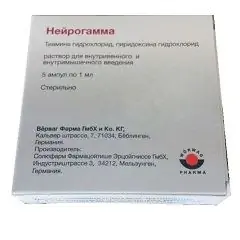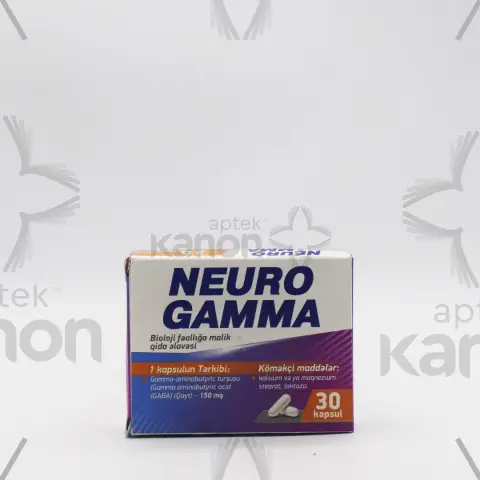Neurogamma
Neurogamma: instructions for use and reviews
- 1. Release form and composition
- 2. Pharmacological properties
- 3. Indications for use
- 4. Contraindications
- 5. Method of application and dosage
- 6. Side effects
- 7. Overdose
- 8. Special instructions
- 9. Application during pregnancy and lactation
- 10. For violations of liver function
- 11. Drug interactions
- 12. Analogs
- 13. Terms and conditions of storage
- 14. Terms of dispensing from pharmacies
- 15. Reviews
- 16. Price in pharmacies
Latin name: Neurogamma
ATX code: A11BA
Active ingredient: Thiamine (Thiamine), Pyridoxine (Pyridoxine)
Manufacturer: Solupharm Pharmazeutische Erzeugnisse, GmbH (Germany)
Description and photo update: 2018-24-10

Neurogamma is a multivitamin preparation.
Release form and composition
The dosage form of Neurogamma is a solution for intramuscular and intravenous administration: a clear liquid with a yellowish-green tint (1 ml in a dark glass ampoule of type 1, 5 ampoules in a blister strip, in a cardboard box 1 or 2 packages).
Composition of 1 ml solution:
- active substances: thiamine hydrochloride - 100 mg, pyridoxine hydrochloride - 50 mg;
- auxiliary components: tartaric acid, water for injection.
Pharmacological properties
Pharmacodynamics
Neurogamma is a combined drug, the effect of which is due to the properties of its constituent components.
Thiamine is involved in the metabolism of carbohydrates, in the Krebs cycle, followed by participation in the synthesis of thiamine pyrophosphate (TPP) and adenosine triphosphate (ATP).
Pyridoxine is involved in protein metabolism, and in part in the metabolism of fats and carbohydrates.
Both vitamins have a potentiating effect on each other, positively affecting the nervous, neuromuscular and cardiovascular systems. In addition, the drug helps to increase blood flow, improve the functioning of the nervous system, and has a positive effect on inflammatory and degenerative lesions of the nerves and locomotor system.
Taking Neurogamma provides quick relief of the symptoms of vitamin B 6 deficiency.
Pharmacokinetics
Thiamine is rapidly absorbed. Within 15 minutes, it enters the bloodstream. It is distributed unevenly in the body: in leukocytes - 15%, erythrocytes - 75%, in plasma - 10%.
Thiamine does not accumulate in the body, therefore, its daily administration is advisable. It is able to penetrate the blood-brain and placental barriers, and it is also found in the milk of lactating women. Thiamine is excreted in the urine. Its main metabolites are thiamincarboxylic acid, pyramine.
Thiamine is stored in the body in the smallest amounts compared to other vitamins. The body of an adult contains about 30 mg of thiamine, of which 80% is in the form of thiamine pyrophosphate, 10% is in the form of thiamine triphosphate, the rest is in the form of thiamine monophosphate.
Pyridoxine also has a rapid absorption (absorbed throughout the small intestine, most of it in the jejunum) and is distributed in the body, acting as a coenzyme after phosphorylation of the group. The connection with plasma proteins is about 80%.
Pyridoxine metabolism occurs in the liver, with the formation of pharmacologically active metabolites - pyridoxal phosphate and pyridoxamine phosphate. The connection of pyridoxal phosphate with plasma proteins is 90%. Pyridoxine penetrates well into body tissues, accumulating mainly in the liver, as well as in the muscles and central nervous system. Penetrates through the placental barrier, is found in the milk of lactating women. Its half-life is 15–20 days. It is excreted mainly by the kidneys (with the intravenous route of administration, 2% is excreted in the bile), as well as during dialysis.
Indications for use
According to the instructions, Neurogamma is indicated for the following diseases and conditions:
- neuropathy;
- neuralgia;
- ganglionitis;
- herpes zoster;
- paresis of the facial nerve;
- plexopathy, including solaritis;
- polyneuropathy;
- myalgia;
- radiculopathy;
- sciatica;
- lumbago;
- nocturnal muscle cramps.
Contraindications
- decompensated heart failure;
- increased sensitivity to drug components;
- age up to 18 years;
- the period of pregnancy and lactation.
Instructions for use of Neurogamma: method and dosage
Neurogamma is administered intravenously or intramuscularly.
Recommended dosage:
- severe manifestations of the disease: 1–2 ml per day for 5–7 days, then 1–2 ml 2-3 times a week for 2 weeks;
- mild cases: 1-2 ml 2-3 times a week for 7-10 days.
Side effects
- immune system: possible allergic reactions such as shortness of breath, tachycardia, shock with circulatory collapse, skin reactions with pruritus and the formation of itchy blisters;
- nervous system: symptoms of peripheral sensory neuropathy or paresthesia, such as tingling and formation in the hands and feet (if the recommended dose is exceeded daily).
Overdose
An overdose of vitamin B 1 leads to nerve paralysis. An overdose of vitamin B 6 causes sensory neuropathy and ataxia.
Too high doses can cause seizures.
Overly rapid insertion results in dizziness, arrhythmias, and seizures.
When a dose of more than 150 mg / kg is administered, symptomatic therapy should be started immediately.
special instructions
Pyridoxine may interfere with the Ehrlich reagent test for urobilinogen.
Influence on the ability to drive vehicles and complex mechanisms
There is no data on the effect of Neurogamma on the ability to drive vehicles and other complex mechanisms that require the speed of psychomotor reactions.
Application during pregnancy and lactation
It is not recommended to take Neurogamma during pregnancy and during breastfeeding.
For violations of liver function
In patients with severe liver damage, high doses of pyridoxine may impair liver function.
Drug interactions
- depolarizing muscle relaxants: their effect is weakened;
- 5-fluorouracil: reduces the effect of thiamine;
- solutions containing sodium hydrosulfite: thiamine when administered intravenously together is unstable;
- copper: accelerates the breakdown of thiamine;
- diuretics: their effect is enhanced;
- levodopa: its effect decreases;
- isoniazid, penicillamine, cycloserine, estrogen-containing oral contraceptives: reduce the effect of pyridoxine.
Neurogamma is incompatible with solutions containing sulfites, as well as with benzylpenicillin, streptomycin, nicotinic acid, oxidizing agents, mercury chloride, iodide, acetate, carbonate, tannic acid, iron-ammonium citrate, phenobarbital, benzyl riboflavicillin metabisulfite, solutions with a pH of more than 3.
Analogs
Analogs of Neurogamma are: Angiovit, Antioxicaps, Aerovit, Vetoron, Geksavit, Gendevit, Revit, Undevit, etc.
Terms and conditions of storage
Store away from light, at a temperature not exceeding 25 ° C. Keep out of the reach of children.
Shelf life is 2 years.
Terms of dispensing from pharmacies
Dispensed by prescription.
Reviews about Neurogamma
There are no reviews of Neurogamma on the Internet.
The price of Neurogamma in pharmacies
The approximate price for Neurogamma in pharmacies is 300 rubles. for 5 ampoules.

Anna Kozlova Medical journalist About the author
Education: Rostov State Medical University, specialty "General Medicine".
Information about the drug is generalized, provided for informational purposes only and does not replace the official instructions. Self-medication is hazardous to health!







